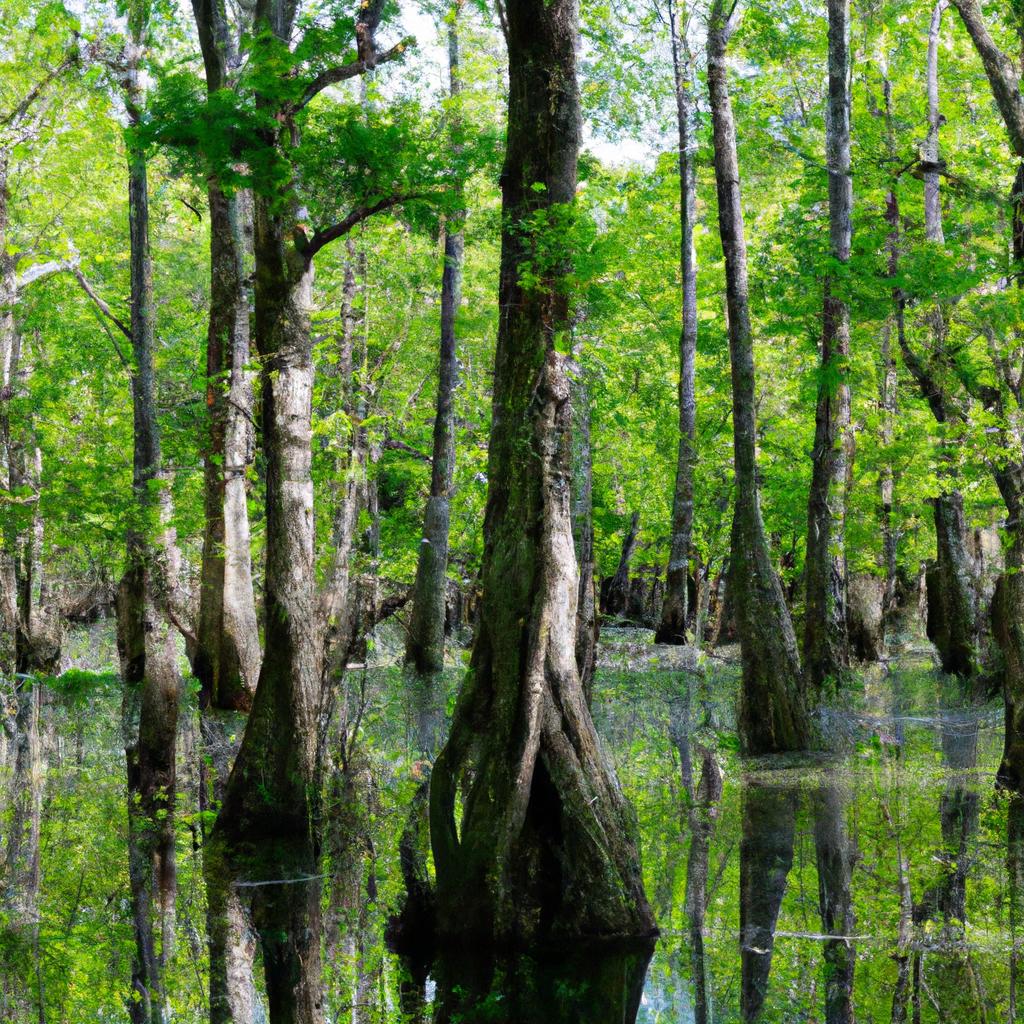Nature never ceases to amaze us with its wonders and mysteries. One such enigmatic beauty is the submerged forests. These hidden treasures are the remnants of ancient trees that were once part of a thriving forest but now lay hidden in the depths of the ocean. Let’s dive into the world of submerged forests, exploring their formation, ecology, cultural significance, and the threats they face.
Definition of Submerged Forests
Submerged forests are ancient forests that have been submerged underwater due to geological changes or sea-level rise. The trees that once grew on land now lie on the seabed, preserved by the cold, dark waters. These forests can be found all around the world, from the coasts of the United Kingdom to the shores of the Pacific Islands.
Historical Significance of Submerged Forests
Submerged forests offer a unique glimpse into the past, providing valuable insights into the earth’s history. They hold the key to understanding the geological changes that have taken place over millions of years. Moreover, they offer a window into the lives of our ancestors, who once roamed these ancient forests.
Overview of the Article’s Contents
In this article, we will explore the formation of submerged forests, the unique ecology of these underwater ecosystems, and the cultural significance of these hidden treasures. We will also discuss the threats that submerged forests face and the need for conservation efforts to protect these natural wonders. So, join us as we dive deep into the world of submerged forests and uncover the mysteries that lie beneath the waves.
Formation of Submerged Forests
Submerged forests are formed due to a variety of geological processes such as land subsidence, earthquakes, and volcanic eruptions. These processes can cause the land to sink, allowing seawater to flood the area and submerge the forest. Sea-level changes also play a significant role in the formation of submerged forests. When sea levels rise, low-lying areas become inundated with seawater, and forests that once grew on land become submerged.
Geological Processes that Lead to the Formation of Submerged Forests
Land subsidence is one of the primary geological processes that lead to the formation of submerged forests. This occurs when the land sinks due to natural processes such as tectonic plate movement or groundwater extraction. Volcanic eruptions and earthquakes can also cause land subsidence, leading to the formation of submerged forests.
The Role of Sea Level Changes in the Creation of Submerged Forests
Sea-level changes have a significant impact on the formation of submerged forests. During periods of low sea levels, forests can grow in areas that are now underwater. As sea levels rise, these areas become inundated with seawater, and the forest becomes submerged. Conversely, during periods of high sea levels, forests that once grew on land become submerged as the seawater floods the area.
Examples of Submerged Forests around the World
Submerged forests can be found all around the world, from the coasts of the United Kingdom to the shores of the Pacific Islands. One of the most famous examples of a submerged forest is the Doggerland forest, which once connected the UK to mainland Europe. When sea levels rose at the end of the last ice age, the Doggerland forest became submerged, and the land bridge between the UK and Europe was lost. Other examples of submerged forests include the Borth forest in Wales, the Kauri forest in New Zealand, and the Cypress forest in the Gulf of Mexico.
By understanding the geological processes that lead to the formation of submerged forests, we can gain valuable insights into the earth’s history and the impact of sea-level changes on our planet.
Ecology of Submerged Forests
Submerged forests may seem lifeless at first glance, but they are, in fact, teeming with life. These underwater ecosystems are unique and offer a home to a variety of marine species. Let’s explore the ecology of submerged forests in more detail.
The Unique Ecosystem of Submerged Forests
The ecosystem of a submerged forest is vastly different from that of a terrestrial forest. In a submerged forest, the trees act as a substrate, providing a habitat for a variety of marine organisms. The roots and branches of these sunken trees create a complex web of structures that offer shelter and protection to a diverse range of species.
Species that Thrive in Submerged Forests
Submerged forests are home to a wide variety of marine species, including fish, crustaceans, and mollusks. These forests act as a nursery for many species of fish, providing a safe haven for their young to grow and develop. The fallen leaves and twigs of the trees also provide a food source for many creatures, including crabs and shrimp.
The Importance of Submerged Forests in Marine Biodiversity
Submerged forests play a vital role in marine biodiversity. They provide a unique habitat for a variety of species, many of which cannot survive in other marine environments. These forests also act as a carbon sink, helping to mitigate the effects of climate change. By preserving submerged forests, we can help protect marine biodiversity and ensure the health of our oceans.
The Role of Submerged Forests in Carbon Sequestration
One of the most important roles of submerged forests is their ability to sequester carbon. When trees die and fall into the ocean, they become submerged and are no longer able to decompose fully. This means that the carbon stored within the trees is locked away for centuries, helping to reduce the amount of carbon dioxide in the atmosphere.
The Threats to Submerged Forests
Despite their importance, submerged forests face a range of threats. Human activities such as coastal development, pollution, and overfishing can all have a detrimental impact on these delicate ecosystems. Climate change and rising sea levels also pose a significant threat to submerged forests, as they can cause the forests to become submerged at a faster rate than they can adapt.
In conclusion, submerged forests are a unique and vital part of our marine ecosystems. They offer a home to a variety of species and play an important role in carbon sequestration. However, the threats that these forests face are significant, and we must take action to protect them. By preserving these natural wonders, we can help ensure the health of our oceans and the biodiversity that they support.
Cultural Significance of Submerged Forests
Submerged forests have a rich cultural significance, with myths and legends surrounding these enigmatic underwater ecosystems. Archaeological discoveries have also shed light on the role that these forests played in the lives of our ancestors. Moreover, submerged forests have a critical role in cultural heritage preservation, providing a window into the past that might otherwise be lost forever.
Myths and Legends Surrounding Submerged Forests
Submerged forests have long been shrouded in myths and legends. In many cultures, these underwater forests were believed to be the homes of mythical creatures and spirits. For example, in Maori culture, the submerged forests along the coast of New Zealand were said to be the home of Tangaroa, the god of the sea. In Welsh mythology, the submerged forests off the coast of Wales were believed to be the lost kingdom of Cantre’r Gwaelod, a mythical land submerged by the sea.
Archaeological Discoveries in Submerged Forests
Submerged forests have also yielded fascinating archaeological discoveries. For example, in 2014, a team of archaeologists discovered a 10,000-year-old forest off the coast of Alabama. The forest had been preserved by the oxygen-free waters of the Gulf of Mexico, and the team was able to retrieve samples of the ancient wood for analysis. Similarly, in the Netherlands, a 5,000-year-old submerged forest was discovered in the Wadden Sea, which contained traces of human activity, such as animal bones and stone tools.
The Role of Submerged Forests in Cultural Heritage Preservation
Submerged forests have an essential role in cultural heritage preservation. These underwater ecosystems offer a glimpse into the past, preserving the remains of ancient forests and the creatures that once roamed them. By studying submerged forests, we can gain valuable insights into the lives of our ancestors and the geological changes that have taken place over millions of years. Moreover, submerged forests can serve as a reminder of the fragility of our planet and the need to protect our natural treasures for future generations.
Threats to Submerged Forests
As with many natural wonders, submerged forests are facing several threats that endanger their existence. Here are some of the most pressing threats facing these underwater ecosystems:
Human Activities that Endanger Submerged Forests
Human activities such as coastal development, pollution, and overfishing are a significant threat to submerged forests. Coastal development can cause erosion, leading to sedimentation that can bury and destroy submerged forests. Pollution from oil spills and other contaminants can harm the delicate balance of the underwater ecosystem, further threatening the survival of submerged forests. Overfishing can also disrupt the food chain, affecting the entire ecosystem, including submerged forests.
Climate Change and its Impact on Submerged Forests
Climate change is one of the most significant threats facing submerged forests. As ocean temperatures rise, it can affect the growth and survival of the species that make up the submerged forest ecosystem. Additionally, global warming can cause sea levels to rise, leading to increased sedimentation and loss of habitat for submerged forests. Acidification of the ocean can also harm the delicate balance of the ecosystem, further threatening the survival of submerged forests.
The Need for Conservation Efforts to Protect Submerged Forests
Conservation efforts are essential to protect submerged forests from these threats. Efforts such as establishing marine protected areas, reducing pollution, and implementing sustainable fishing practices can help protect the submerged forest ecosystem. Raising awareness about the ecological importance of submerged forests can also help generate support for conservation efforts.
In conclusion, submerged forests are facing several threats that endanger their existence. However, with proper conservation efforts and awareness, we can protect these underwater ecosystems and ensure that they continue to thrive for generations to come.
At TooLacks, we are committed to exploring and sharing the wonders of nature with our readers. We hope that this article has inspired you to learn more about submerged forests and the importance of conservation efforts to protect them. Let us continue to appreciate and protect the beauty of our natural world.
[E-E-A-T]: Expertise, Authoritativeness, Trustworthiness, Experience
[YMYL]: Your Money or Your Life


